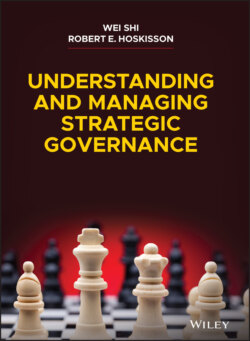Читать книгу Understanding and Managing Strategic Governance - Wei Shi - Страница 13
INTERNAL GOVERNANCE
ОглавлениеAlthough corporate executives are responsible for making a myriad of strategic decisions that contribute to a firm's competitiveness and performance, their choices are constrained by internal corporate governance actors such as the board of directors and employees. While much has been written about internal governance, especially about boards, no systematic analysis exists on how internal governance actors influence strategic decisions. We examine relatively unchartered territory by examining the actors' impacts on decision-making, beginning with an analysis of the different board attributes and tools that directors use to govern firm executives and shape decisions. Our discussion will include a look at how employees, as another important internal stakeholder, can also shape corporate governance and strategic decisions.
Corporate governance, though more challenging than in the past, is critical to firm success. Under its scope, directors make the vital decision of selecting an appropriate CEO to guide the strategic direction of the firm. If the board makes an unwise choice, not only in selecting but also in setting the compensation of the strategic leader, shareholders and stakeholders all suffer. As such, effective leadership succession plans and appropriate monitoring and direction-setting efforts by the board of directors contribute positively to a firm's performance. Boards face unforeseen circumstances, as in the need to replace a CEO due to financial misconduct. In this case, research shows that directors tend to choose a successor with a degree from a religious university, since such a choice has been shown to reduce the likelihood of misconduct.12 Similarly, when KPMG, one of the big four accounting firms, was questioned by the Internal Revenue Service and found culpable of engaging in inappropriate tax shelters for years in the late 1990s and early 2000s, the directors of the company hired a new CEO, appointed a former judge onto its board, and established board committees focused on fostering better professional ethics and risk compliance norms through its operations committee. Likewise, they pursued vigorous ethics and risk training for all employees.13 Their efforts saved KPMG from suffering a fate similar to Arthur Andersen, a former “Big Five” accounting firm that ceased to operate due to the Enron fiasco.
In addition, choosing an outside versus an inside CEO (one who is currently employed at the firm) can lead to more strategic risk taking for the organization, but such increased risk taking can result in performance extremeness.14 Increased strategic risk taking is analogous to swinging for the fence in baseball (trying to hit a home run). Although Babe Ruth set home run records, he also set record strikeouts at the plate. Appropriate executive compensation also influences risk taking. Too much emphasis on CEO stock options leads to excessive strategic risk taking and can lead to some good performance, though poor performance (striking out) is more likely.15
